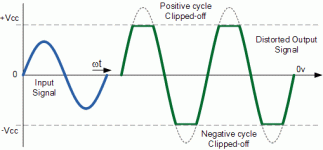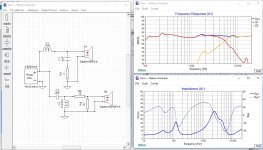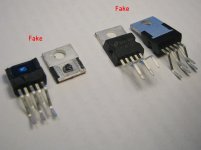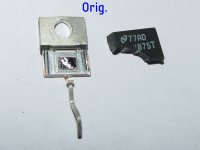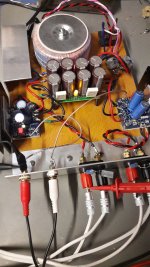Hang on! Have I got this all wrong.
Dedicated power amps have no volume control. The volume control is a series resistor in the signal input path. Wasn’t my clean power measurement based on a fixed input signal voltage. If the amp is set to max voltage (low or no volume pot signal attenuation) does it not perform linearly until an increasing input signal voltage drives it into clipping?
If this is the case in my setup, I can probably rerun my clipping tests (with preamp in circuit. Previously ran a clipping test on the preamp, it also distorts above about 80% max volume) and find max clean power for system . Then where does a practical max volume dial setting get set (based on dynamic headroom needs)?
Dedicated power amps have no volume control. The volume control is a series resistor in the signal input path. Wasn’t my clean power measurement based on a fixed input signal voltage. If the amp is set to max voltage (low or no volume pot signal attenuation) does it not perform linearly until an increasing input signal voltage drives it into clipping?
If this is the case in my setup, I can probably rerun my clipping tests (with preamp in circuit. Previously ran a clipping test on the preamp, it also distorts above about 80% max volume) and find max clean power for system . Then where does a practical max volume dial setting get set (based on dynamic headroom needs)?
Sorry to bring this post back to life but I have another questions about this amp’s capability.
I measured ~30w continuous clean power with one channel driven (with a 1khz sine wave (IIRC). I recall that this was achieved at about 80% dial rotation.
At this level does the amp have any dynamic headroom capacity? If not, how can I determine maximum volume setting?
Dynamic HR has more to do with the power transformer and filter caps and much less to do with the amp circuit itself. The supply voltage will sag from driving a load than just sitting idle. Most music puts much less of a load on the supply than continuous sine waves at clipping, Therefore, the amp will be able to put out more bursts of power with music, therefore having some dynamic headroom.
If you hear distortion at desired listening levels, in your case, I'd look at more sensitive speakers since you said your speakers may be near their limits. Some smaller speakers sound stressed when driving close to their power limits.
Volume control isnt a series resistor but a voltage divider (if you've wired it correctly!) It doesn't contribute to distortion.
OK, forgot that. Big misunderstanding on my part.
The speakers are DIY Helium Micro Monitors. The full range driver is rated at 30w and they have a nominal impedence of about 5ohms according to the designer IIRC
I don’t currently have any distortion.
Are there any issues with running the amp at max volume when the preamp is used to control the volume?
I don’t currently have any distortion.
Are there any issues with running the amp at max volume when the preamp is used to control the volume?
Attachments
Last edited:
Fine to run at full volume if you're using a preamp. Doing so will minimise the effective output impedance of your preamp.
Power dissipation by the LM1875 will be low with no signal input?
Dynamic HR has more to do with the power transformer and filter caps and much less to do with the amp circuit itself. The supply voltage will sag from driving a load than just sitting idle. Most music puts much less of a load on the supply than continuous sine waves at clipping, Therefore, the amp will be able to put out more bursts of power with music, therefore having some dynamic headroom.
If you hear distortion at desired listening levels, in your case, I'd look at more sensitive speakers since you said your speakers may be near their limits. Some smaller speakers sound stressed when driving close to their power limits.
Hi John
So with my 120VA 8800uF per channel supply, even at output levels close to max power, there will likely be sufficient current to reproduce music transient peaks without clipping? (I don’t think there is a firm answer to this Q because the dynamic range of media is highly variable, or so I have read). I guess a clipping indicator would be useful to help protect the tweeter.
Last edited:
Hi John
So with my 120VA 8800uF per channel supply, even at output levels close to max power, there will likely be sufficient current to reproduce music transient peaks without clipping? (I don’t think there is a firm answer to this Q because the dynamic range of media is highly variable, or so I have read). I guess a clipping indicator would be useful to help protect the tweeter.
Yes, there's no easy answer to that.
Although I did mention before that headroom is more related to the power supply, the LM1875 has a safe operating area limiter that I measured to engage at 3 Arms with a continuous signal. At the ICs max voltage of +/- 30v, the output into a non inductive 8 ohm resistor was 42.3 watts or 2.3A. This means that there is headroom for supply voltages (+/- 25v or less) and "normal" reactive loads from speakers.
The best way to check if the amplifier is affecting the sound in any way is to compare the signal going in with the signal coming out using a differentiator. The only difference you should see is that the output signal is much larger (of course!) and a small phase shift. After compensating for these, the output from the differentiator would be very small showing noise +distortion. Only when the amp clips or has some other issue would the output be large to trigger an indicator, alerting you to a problem.
Small phase shift....
Not that small. Check on this, you'll be surprised.
If your talking about speaker reactance, of course. I'm talking about phase shift (input vs. output) generated within the amplifier due to all the poles in the circuit. There is a small amount in a non inverting amplifier in the audio passband.
I am not talking of speaker.
I am talking of this, from post #172.
I am talking of this, from post #172.
The best way to check if the amplifier is affecting the sound in any way is to compare the signal going in with the signal coming out using a differentiator. The only difference you should see is that the output signal is much larger (of course!) and a small phase shift.
Some Pictures. 1st is a TDA2030, the Rest different LM1875 I found on my HDD. No Pics from the Net, all by me, and I think they're all original LM1875, because to fake these things is economically absolute Nonsense.
The Chinese just buy totally huge amounts of the parts needed, and so they can sell an Amp for 2€/$.
Fake and original LM1875 - crystal dimention.
Attachments
Today my amp started playing up☹️
I started losing the right channel output at the speaker. Wiggling the volume knob fixes it temporarily. I had also noticed some odd treble sounds recently at low volume (could be my imagination though)
The amp had been doing most duty as a power amp where I had the volume set at 80% rotation while controlling the music volume with a DIY preamp. It was like his for most of the past year.
Could the Alps Blue Velvet 20k pot (maybe knock off from eBay) have degraded when stuck in a partially closed position for long periods of time?
I have not looked inside yet to see if anything else has issues, but I have just ordered a replacement pot from RS Components this time!
Would it be simple and worthwhile to install a pot bypass circuit for when the amp is being used as a simple power amp only! And could this avoid this issue?
Most likely I will not have to use a preamp anymore as I may continue to use more sensitive speakers (Q Acoustics 2010).
Any thoughts?
Thanks
👍👍🏾
I started losing the right channel output at the speaker. Wiggling the volume knob fixes it temporarily. I had also noticed some odd treble sounds recently at low volume (could be my imagination though)
The amp had been doing most duty as a power amp where I had the volume set at 80% rotation while controlling the music volume with a DIY preamp. It was like his for most of the past year.
Could the Alps Blue Velvet 20k pot (maybe knock off from eBay) have degraded when stuck in a partially closed position for long periods of time?
I have not looked inside yet to see if anything else has issues, but I have just ordered a replacement pot from RS Components this time!
Would it be simple and worthwhile to install a pot bypass circuit for when the amp is being used as a simple power amp only! And could this avoid this issue?
Most likely I will not have to use a preamp anymore as I may continue to use more sensitive speakers (Q Acoustics 2010).
Any thoughts?
Thanks
👍👍🏾
Hi
hmm...thats the reason i do not like the pot in the signal chain.
yes its could be that the steady position at the pot is getting crunch after a while.
if you us an pre amp why you use a volume pot in the "power amp"?...but this is your comfort and your decision
you can de-install the pot and use the signal by the rca directly at the amp board as we have done in the other thread.--> see attachment. rca- cable- board
chris
hmm...thats the reason i do not like the pot in the signal chain.
yes its could be that the steady position at the pot is getting crunch after a while.
if you us an pre amp why you use a volume pot in the "power amp"?...but this is your comfort and your decision
you can de-install the pot and use the signal by the rca directly at the amp board as we have done in the other thread.--> see attachment. rca- cable- board
chris
Attachments
- Home
- Amplifiers
- Chip Amps
- LM1875 Amp layout

